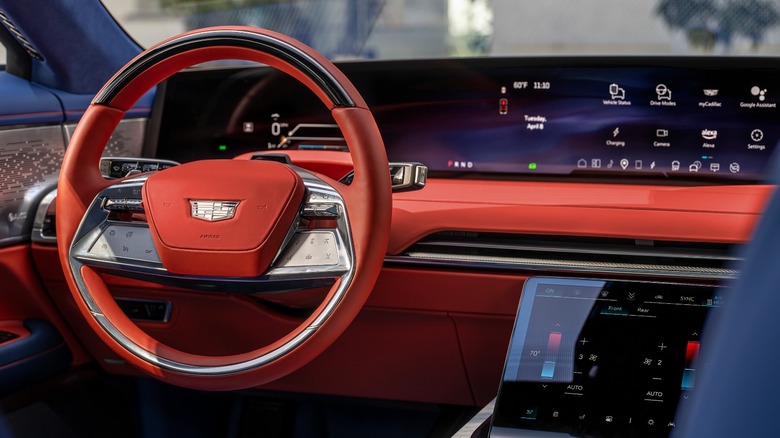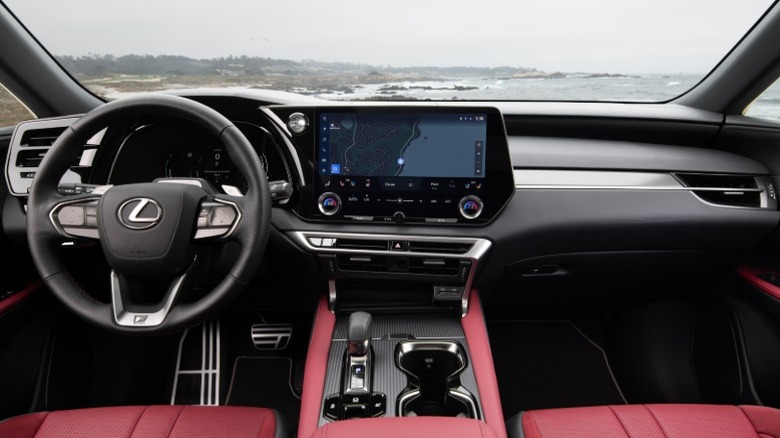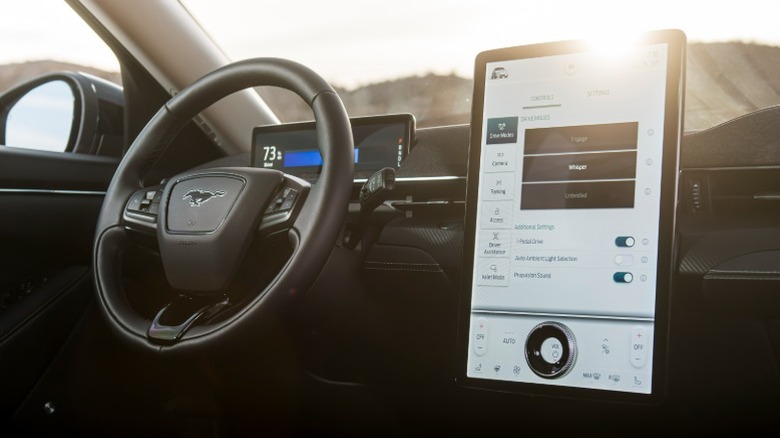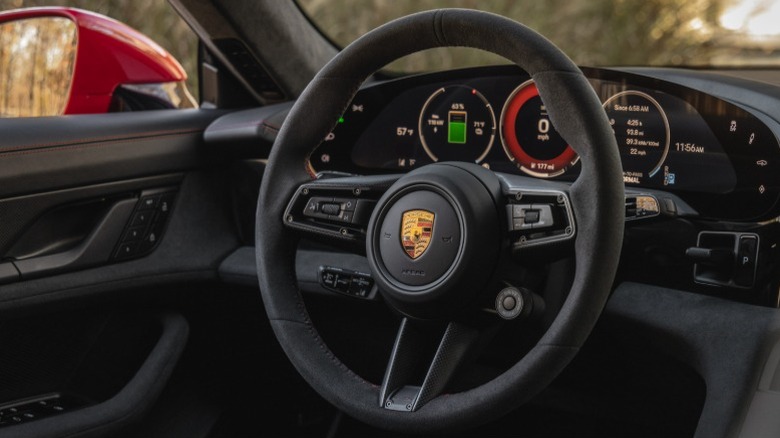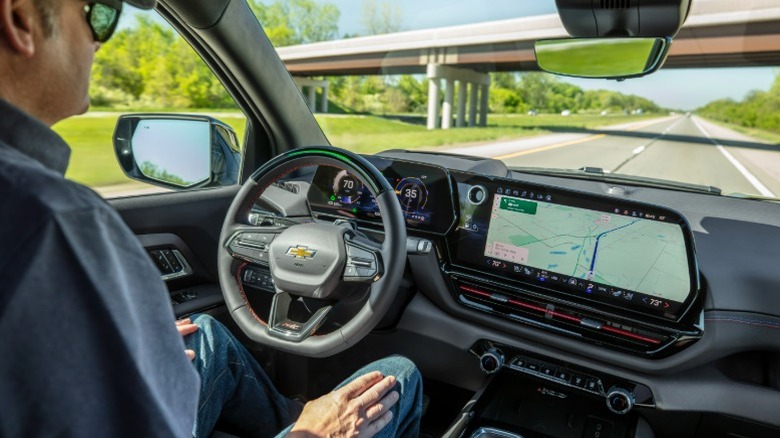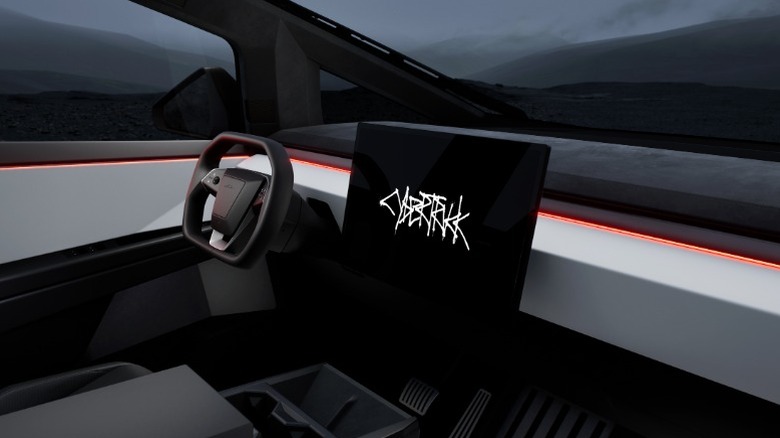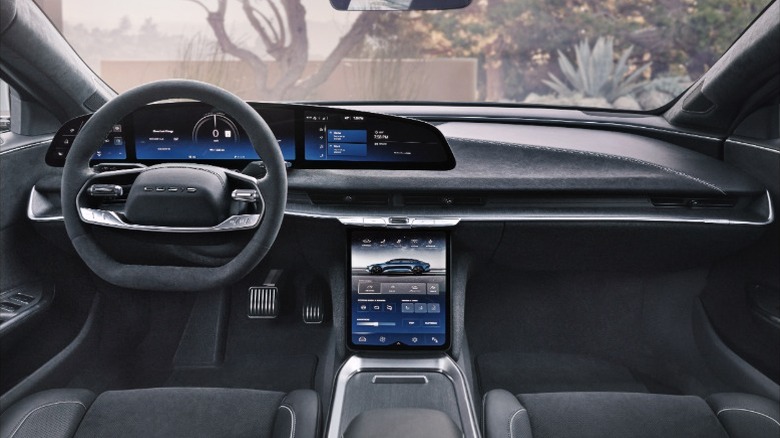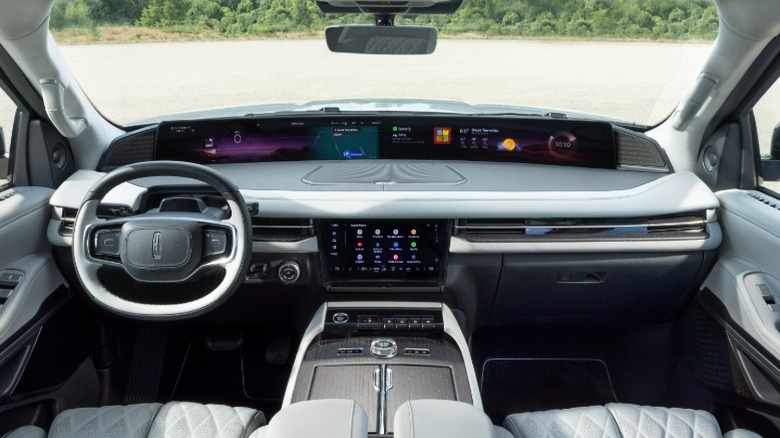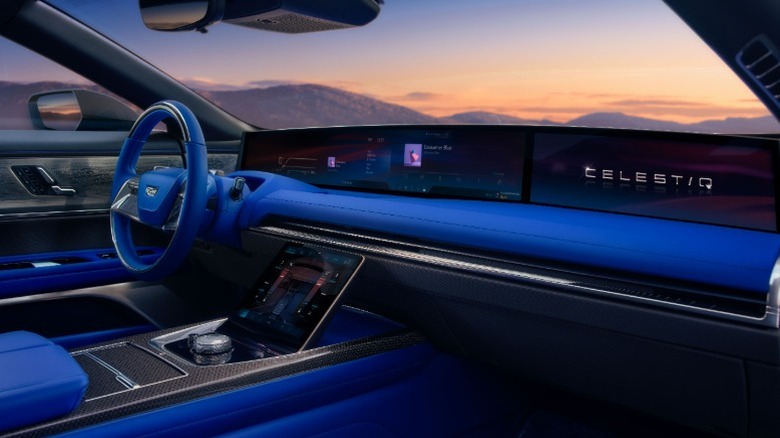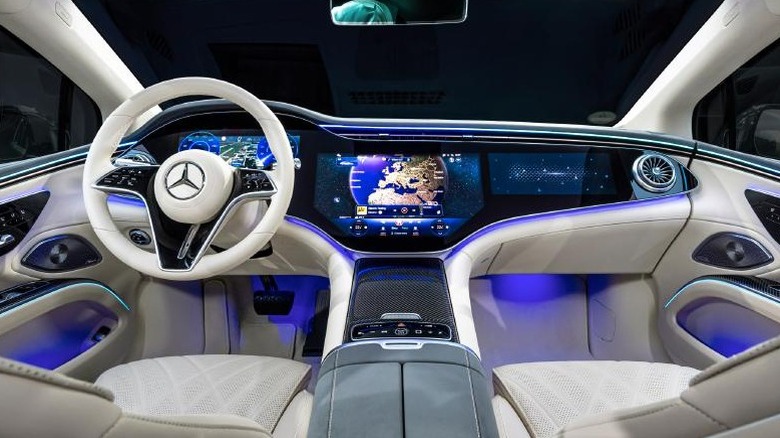10 Cars With The Biggest Screens Available In 2025
Over the past decade or so, cars have become more and more like the other tech we use daily. Our EVs get OTA updates, just like our phones; some automakers have experimented with implementing paywalls for features, much like apps; and software glitches can bring even the best-made cars to their knees.
Another way in which our cars are fast becoming like our other devices is the prevalence of screens. It seems that the days of tactile controls and analog gauges are gone, replaced by a proliferation of touchscreens and digital instrument clusters. In-car screens aren't anything new, of course, but it's impossible to deny that they've become a bigger — literally, too, judging by some of the cars we'll discuss later — part of our automotive experience. Case in point: some market observers expect the automotive display market to grow to a massive $48.9 billion by 2034, up from $16 billion in 2024.
Now, not everyone is a fan of screens in cars, with critics pointing to the lack of physical feedback and the need to take one's eyes off the road to adjust basic functions. Despite that, though, it seems like the in-car screen is here to stay, whether in the form of relatively small 14-inch units or massive 50-plus-inch behemoths. So if you're a fan and want to know which cars offer the most screen real estate in 2025, here's a list for you.
Lexus RX — 14.0 inches
We'll start with Lexus' RX SUVs, some of which come with a 14-inch touchscreen. This larger unit isn't available on all the models, with the most affordable versions of the RX 350 being limited to the standard 9.8-inch touchscreen (as are all F Sport variants). However, it's an option for the car's Premium trim and becomes standard issue on Premium+ and Luxury versions.
As you might expect, the larger 14-inch display is also standard on the more expensive members of the RX family, such as the RX 450h+ and the too-pricey-for-its-own-good RX 500h F Sport. As for the display itself, Lexus' designers placed it at a slight tilt to better suit the driver, with the added touch of a small central knob that controls power and adjusts volume — a nice touch that returns a bit of tactility to the modern driving experience.
You get wireless Apple CarPlay and Android Auto as standard, but you'll need to stump up extra money to make full use of the screen: Extra features like the navigation (Drive Connect) and the ability to stream audio via the car's wireless data connection (Integrated Streaming) require you to subscribe to Lexus' Go Anywhere or Premium Plan, respectively. The 14-inch screen comes with a three-year subscription to Drive Connect as standard, though, but you'll eventually need to start paying if you like the feature and want to hold on to your Lexus SUV for more than three years.
Ford Mustang Mach-E — 15.5 inches
The Mustang nameplate may not necessarily be associated with cutting-edge tech, but the Mustang Mach-E is an entirely different beast. Sure, it echoes some styling cues and has the iconic Mustang badge up front, but this isn't a low-slung muscle car. Instead, it's an EV crossover, albeit one that can hit 60 mph quicker than even the Mustang Dark Horse.
And since the Mach-E is an EV, it shouldn't surprise you that it comes with quite a sizable screen in the cockpit. Ford's all-electric crossover comes with a 15.5-inch screen that sits vertically in the dashboard, not unlike the pre-refresh Tesla Model S. The screen gives you access to the controls and features you'd expect on a modern EV, including selecting driving modes and Ford's Sync 4A functionality. The latter includes Apple CarPlay and Android Auto support, plus optional paid-for features such as SiriusXM 360L and Connected Navigation, which is Ford's name for its in-car navigation system.
Sync also lets owners maintain separate driving profiles, with room for three users — great if multiple members of your family regularly take the Mach-E out — and one guest. That said, it's to Ford's credit that the Mustang Mach-E isn't defined by its infotainment. As we found out when we reviewed a 2023 Mustang Mach-E, Ford's not-quite-a-Mustang EV SUV is a fast, fun, and reasonably luxurious car that's only somewhat let down by its price and charging network woes.
Porsche Taycan — 16.8 inches
When the production version of the Porsche Taycan debuted in 2019, it was the storied German automaker's first step into the luxury EV market. It seemed a smart move, too, with the new EV outselling the company's stalwart 911 in 2021 — aided, undoubtedly, by its sheer electric power and signature Porsche handling. The updated 2025 Porsche Taycan retains all of that and more, with the top-of-the-line Taycan Turbo GT packing 1,019 hp of power and a frankly ludicrous 0-60 mph time of 1.9 seconds (as tested by Car and Driver).
Of course, any modern EV worth its salt needs to offer more than just driving thrills, especially not when even the base model costs just over $100,000. Interior fittings are just as important at this price point, and the Taycan doesn't disappoint there. It has two central infotainment touchscreens that measure 10.9 and 8.4 inches, an optional 10.9-inch front passenger touchscreen, and an optional set of two 10.1-inch rear screens that Porsche calls Porsche Rear Seat Entertainment (PRSE).
However, the biggest screen in the Taycan is the one for the driver. Porsche's EV has one of the largest instrument clusters on this list, coming in at 16.8 inches. And it's not just for digital gauges, either; the driver's screen can show the map when using Porsche's built-in navigation and can also show Apple CarPlay info, although Android Auto support is sadly missing.
Chevrolet Silverado EV — 17.7 inches
The Ford vs GM debate will rumble on until the cows come home, and now we can add one more point of contention between the two long-running American automakers: screen sizes. For our list, though, GM strikes the first blow, with the Chevrolet Silverado EV scoring a decisive victory over Ford's Mustang Mach-E thanks to its larger screen.
The Silverado EV is an all-electric pickup truck that shares a platform with other large GM EVs like the Cadillac Escalade IQ and supremely over-the-top GMC Hummer EV. All non-commercial Silverado EV buyers will get a 17.7-inch infotainment display in the middle of the dash, paired with an 11-inch digital instrument display. Even though the two screens look to be housed in a single dashboard unit, GM has opted to keep the two separate, so 17.7 inches is all we'll count here.
The 17.7-incher is standard on the Silverado EV LT and gone-for-2026 Silverado EV RST. GM hasn't specified whether the upcoming Silverado EV Trail Boss will have the same infotainment setup, but the fact that GM's planned MSRP for its off-road capable Trail Boss is higher than most versions of the LT tells us that it probably will stick to the same screen configuration. The LT and Trail Boss aren't the only versions of the Silverado EV available, though: there's also the Work Truck, which is a no-frills commercial version that drops to an 11-inch screen to keep the price down.
Tesla Cybertruck — 18.5 inches
It wouldn't be a list of large car screens without a Tesla, would it? The American EV maker has had big central screens in its cars ever since the Model S debuted in 2012, and that tradition continues with the Cybertruck's 18.5-inch central touchscreen.
The Cybertruck adopts the now-standard horizontal screen layout that Tesla introduced with the Model S' 2021 refresh, even if the Cybertruck's long and troubled development kicked off before said change in the touchscreen orientation. The functionality of the front screen should be familiar to anyone who's sat in a Tesla, though, as it essentially serves as the hub for all the Cybertruck's settings, including managing driver profiles and engaging any of its alternate driving modes — all of which can be tweaked via the touchscreen, too.
The screen also shows useful information in its off-road modes, including tire pressures, motor temperature, and the state of the differential locker. Drivers also get to see the truck's current ground clearance and angle information, such as the roll and pitch, as well as the direction of travel. As you might expect with a modern EV, the Cybertruck doesn't just have a front screen, although it's not quite as screen-heavy as some other cars on this list: Rear passengers get a single 9.4-inch touchscreen that allows them to adjust climate control and enjoy Tesla's built-in entertainment features.
BMW i7 — 31.3 inches
BMW's i7 is a special car for a couple reasons, at least for the purposes of this list. It's the only car here with more than one screen large enough to make the list. It's also the only car on this list for its dedicated rear passenger screen, which is in itself quite special.
However, first let's take a look at the front screen. The i7's front screen is, as will become a trend with the upcoming entries, a 27.2-inch two-in-one unit that combines a 12.3-inch digital instrument cluster with a 14.9-inch infotainment touch screen. BMW calls it the Curved Display, and it takes pride of place up front. As impressive as the Curved Display is, though, it's nothing compared to what awaits the i7's rear passengers.
BMW may be known for promoting its cars as "the ultimate driving machine," but the i7 is likely a BMW that most would rather ride in as a passenger, as our Chris Davies found when he tested the i7 back in 2023. The luxury accoutrements for rear passengers play a huge part in that, especially the optional 31.3-inch BMW Theater Screen. This is an ultra-wide 8K screen that drops down from the ceiling in the car's Theater Mode, which also makes automatic adjustments to the seat position, interior lighting, and sunblinds. Couple all of that with a Bowers & Wilkins sound system, and you get quite the rear-seat setup for movies or gaming.
Lucid Air — 34 inches
Though Lucid may not have the name recognition of Tesla amongst more casual EV users, the underdog automaker has made quite a splash since the Lucid Air EV debuted in 2021 with Tesla-beating range and no shortage of performance — albeit for a pretty penny. Later models like the Lucid Air Pure RWD that we reviewed tried to redress the balance, but Lucid's EV four-door remains a premium-priced option compared to Tesla's offerings.
Just as well, then, that the driver at least gets significantly more screen real estate when sitting behind the wheel. Tesla's Model S has a single 17-inch touchscreen, but the Lucid Air doubles that with a 34-inch screen that Lucid calls the Glass Cockpit. That said, it's not quite the same as Tesla's offering: Unlike the Model S' single screen, the Lucid Air's Glass Cockpit is three displays in one monolithic unit that sits behind the steering wheel. A small section on the left shows basic information, such as headlight and door lock status; a central digital instrument cluster, just like most other EVs; and an infotainment section on the right handles the usual media and navigation duties.
Lucid didn't stop there, though: The Air also has what it calls the Pilot Panel, which is a retractable 12.5-inch display in the center of the cockpit that allows touch access for driver and passengers to all the essential settings tweaks modern EVs have to offer. You know the drill: drive modes, seat settings, climate control, and interior lighting, to name a few examples.
Lincoln Navigator — 48 inches
Ford Motor Company's second entry on this list is Lincoln's long-running flagship SUV. The Lincoln Navigator has been a fixture of full-size SUV opulence since it debuted for the 1998 model year. The most recent iteration of the luxury SUV keeps that trend going with features like Lincoln Rejuvenate, a full-sensory massage experience designed to help drivers unwind after a long day.
However, the Navigator isn't just about what happens after the drive. Front-seat occupants are treated to a massive 48-inch screen that sits on top of the dashboard and spans most of its width. Positioned to keep information close at hand without distracting the driver, the screen is a carryover from the Lincoln Nautilus and split into several sections, including one for the passenger. The Navigator's screen has a party trick up its sleeve, too: When parked, driver and passenger can essentially split the screen in two via the Navigator's "Pano Mode." This allows the driver to watch a video while the passenger plays a game, for example.
As impressive as the primary screen is, though — and it is quite a stunner, as we found out during our first drive of the 2025 Navigator — it isn't the one that drivers will be interacting with. Like the Lucid Air, the Navigator has a secondary touchscreen for all the necessary interactions with the car's systems (including deciding what goes on the 48-inch screen). An 11.1-inch unit takes care of that, and it's located in the center console.
Cadillac Celestiq — 55 inches
The game of screen size one-upmanship between Ford and GM can only have one winner, and as of mid-2025, it's GM. While the 48-inch screen in the Lincoln Navigator is undoubtedly impressive, GM has it firmly beat with a 55-inch unit present in several of its premium EVs, including the Cadillac Celestiq.
Like the Lincoln and BMW screens we've discussed, the Celestiq's screen — which has since made it to the Cadillac Escalade IQ and the gas-powered 2025 Escalade — is part of a wholly luxury-focused interior, serving as icing on the cake for well-heeled customers looking for the final word (or close to it) in EV opulence. As we discussed in our first drive of the 2025 Celestiq, you don't just buy one of these off the shelf. Instead, owners head to a Michigan house designed by Finnish-American architect Eero Saarinen, where they work with a team to create a properly bespoke interior fitting their tastes.
While Cadillac hasn't expressed it outright, images of the Celestiq's interior indicate that the 55-inch, 8K resolution screen is much like those on the Lucid Air and Lincoln Navigator, with multiple sections in one. There's a dedicated area for the digital instrument cluster, a screen for the passenger, and a large central display. And, like on the Lincoln, the Celestiq has a smaller touchscreen in the center console... plus three more for the rear passengers. That's the least you can expect given its $300,000-plus price tag, of course.
Mercedes-Benz EQS SUV and Sedan — 56 inches
Finally, we come to the big dog of in-car screens, the king of the hill of pixels and glass: the Mercedes-Benz EQS. Well, more specifically, the kings of the hill, as Mercedes-Benz's class-leading screen is available on all versions of its electric EQS SUVs and sedans, from the relatively lowly EQS 450+ SUV up to the 650-hp, $150,000 AMG EQS Sedan.
Mercedes-Benz's 56-inch unit, which it calls the MBUX (Mercedes-Benz User Experience) Hyperscreen, follows the trend of having multiple separate units behind one plane of glass. The curved screen combines a 12.3-inch LED instrument cluster that sits in front of the driver with 17.7- and 12.3-inch OLED touchscreens. That setup may seem pretty standard, but it's worth noting that Mercedes-Benz first announced the MBUX screen in 2021, well before GM or Ford debuted their massive multi-unit screens. And despite its relative age, it's still one of the highlights of the SUV, as we observed when we took a 2023 Mercedes-Benz EQS SUV for a spin.
Mercedes engineers also added a few nice touches to the user experience, with the touchscreens offering haptic feedback for select controls. While that isn't likely to make up for the lack of physical buttons, it's better than nothing. Mercedes-Benz has also included an eye-tracking feature, which dims the screen if it detects the driver staring at the screen for too long. Again, probably not a guaranteed fix for distracted driving, but welcome all the same.
